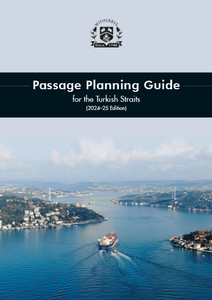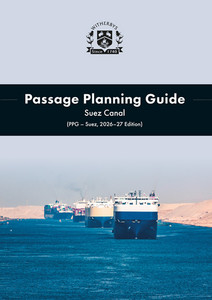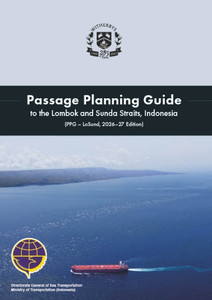
This Guide details the requirements and preparations for Masters and Navigating Officers on vessels intending to transit the Panamax or Neopanamax locks of the Panama Canal.
Passage Planning Guide: Panama Canal (2024-25 Edition) is the most comprehensive operational and navigational Guide to the Panama Canal.
The goal for Ship Operators, Masters and the Panama Canal Authority (ACP), is that vessels arrive fully prepared to transit and with no unnecessary delays. This Guide will help operators achieve that goal.
As an example, in 2024, sophisticated tankers are still arriving for canal transit with mooring wires presented on arrival for transit, rather than the synthetic mooring lines that are required under ACP's 'Vessel Requirements', Section 9 Mooring Lines.
This Guide provides emphasis on:
- The documentary submissions required by the Master
- the operational aspects of a transit of the Panama Canal
- the navigational elements and necessary contingencies.
Shipmasters will know that a canal transit means a very long day and that are any number of potentials for stress, surprise and unexpected or unannounced occurrences. This Guide is the best available tool to prepare the Master and their officers for a successful transit, by instilling in them the knowledge and confidence necessary for proper preparation and the high level of situational awareness and readiness required for each stage of the transit.
The Panama Canal is a controlled and managed waterway that connects the Pacific and the Atlantic Oceans, at the Isthmus of Panama. While the Canal is strictly governed, and pilotage is compulsory, it is also extremely busy and requires that ships' officers are fully familiar with what is required from the ship in order to ensure a safe and timely transit of the Canal. The Canal is regulated and managed by the Autoridad del Canal de Panama (ACP) (the Panama Canal Authority).
The Canal is open for commercial operations 24 hours per day and all communications are conducted in the language of English, both on the bridge and between ships. Although the Atlantic Ocean is geographically to the North and East of the Canal and the Pacific Ocean is to the South and West of the Canal, due to its winding shape the terms 'Northbound' and 'Southbound' are used for simplicity of communications, eg 'Southbound' refers to a passage from the Atlantic to the Pacific Ocean.
Section 1 - Guidance Notes on the Panama Canal
1.1 Introduction
1.2 The Panama Canal Authority (ACP)
1.3 Panamax and Neopanamax Locks: Max. Draught, Beam & LOA
1.4 Recent Requirements for Neopanamax Vessels
1.5 Bridges - Overhead Clearance
1.6 Maximum Limits in the Panamax and Neopanamax Locks
1.7 Panama Canal - Transit Reservation System
1.8 Panama Canal Water Level
1.9 Master's Guidance for Arriving Ships (Notification and Papers)
1.10 Pilotage
1.11 Ship's Conduct with the Pilot on Board
1.12 Locks and Mooring Arrangements
1.13 Use of Tugs
1.14 Locomotives/Mules in Panamax Locks
1.15 Designated Contingency Locations in the Panama Canal
1.16 Passage Planning
1.17 Tidal Information
1.18 Climate and Meteorology
1.19 MARPOL Requirements
1.20 Fuel Requirements and Bunkering Areas
1.21 ISPS Code Requirements
1.22 Emergencies
Section 2 - The Panama Canal - Southbound
Section 3 - The Panama Canal - Northbound
Annexes
Annex 1 Pre-Entry Bridge Team Meeting
Annex 2 Documentation Prior to First Transit
Annex 3 Visibility Requirement for the Panama Canal
Annex 4 Flag Signals in the Panama Canal
Annex 5 Bitts, Chocks and Pilot Shelters for Ships Transiting the Panama Canal
Annex 6 Pre-Arrival Checklist for Ships' Equipment
Annex 7 Considerations for LNG Carriers Transiting the Panama Canal
Annex 8 Considerations for LPG Carriers Transiting the Panama Canal
Annex 9 Mooring in the Neopanamax Locks (New Locks)
Annex 10 Mooring in the Panamax Locks (Old Locks) - 'Relay' Procedure
Annex 11 Neopanamax Canal Section Limits
Annex 12 Panamax Canal Section Limits
Witherbys
Witherbys titles are developed using scripts developed by technical experts that are peer reviewed within work groups. Typically, they seek to improve understanding of the regulations, recommendations and guidelines issued by Industry.
Witherbys staff have significant expertise in the fields of navigation and hazardous cargoes as well as in the presentation of complex subjects in a graphic and easy to understand manner.
- Number of Pages:
- 144
- ISBN:
- 1914993833
- Book Height:
- 300 mm
- Book Width:
- 210 mm
- Weight:
- 1.2 kg
- Author:
Witherbys
- Published Date:
- June 2024
- Publication Date:
- June 2024
- Preview:
- Yes






